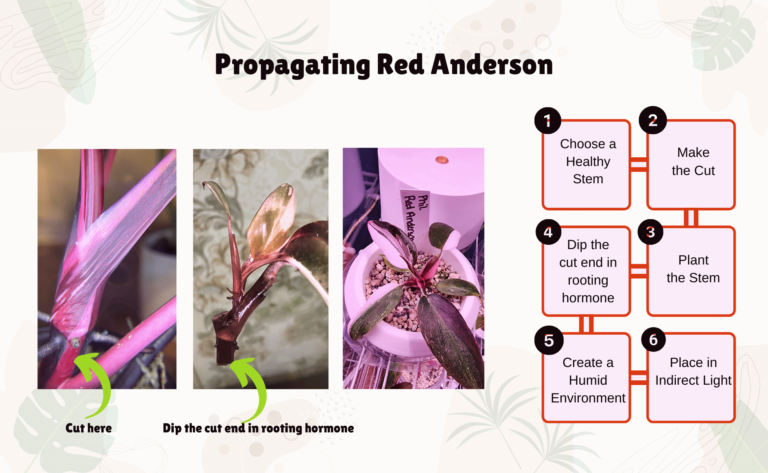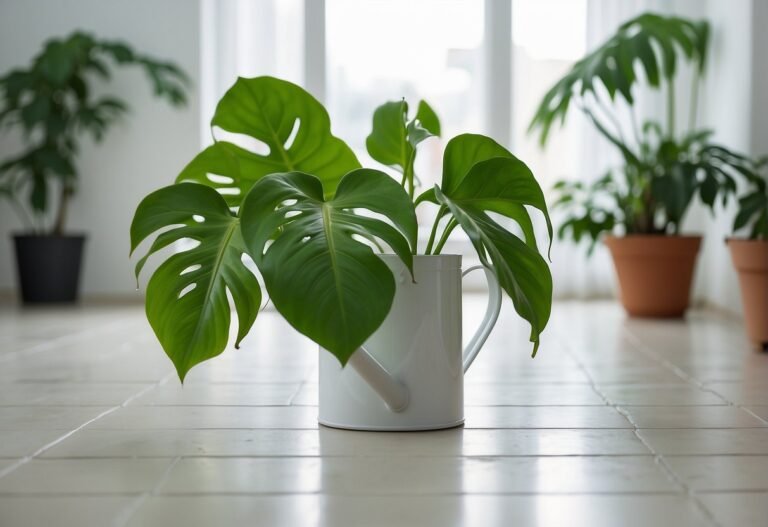Philo Gloriosum Zebra: So Fancy, It Needs Its Own Instagram
Philodendron Gloriosum Zebra, the elusive beauty that’s been keeping plant enthusiasts up at night. You’ve seen it on Instagram, drooled over it in-plant shops, and now you’re ready to bring this striped stunner home.
But wait! Before you dive headfirst into the world of this rare aroid, let’s unpack everything you need to know to keep your new leafy friend thriving, not just surviving.
Information Table: Philodendron Gloriosum Zebra
| Feature | Details |
| Scientific Name | Philodendron gloriosum ‘Zebra’ |
| Origin | Tropical rainforests of Colombia and Ecuador |
| Growth Habit | Terrestrial creeper (rarely climbs) |
| Leaf Shape | Large, heart-shaped, velvety texture |
| Leaf Color | Deep green with distinctive yellow or white stripes |
| Light Needs | Bright, indirect light |
| Water Needs | Keep soil consistently moist but not soggy |
| Humidity | High humidity (60-80%) |
| Soil | Well-draining, airy mix rich in organic matter |
| Fertilizer | Balanced liquid fertilizer during the growing season |
| Propagation | Stem cuttings or division |
| Pests & Diseases | Susceptible to common houseplant pests and root rot if overwatered |
| Toxicity | Toxic to pets and humans if ingested |
The Gloriosum Zebra: Not Your Average Joe
Philodendron Gloriosum Zebra, a name that rolls off the tongue like a botanical spell, is a variegated cultivar of the already stunning Philodendron Gloriosum. This rare beauty hails from the lush rainforests of Colombia, where it’s learned to thrive in the dappled sunlight of the forest floor.
But what sets this particular philodendron apart from its leafy brethren? It’s all in the stripes, folks! The Gloriosum Zebra sports striking white or cream-colored stripes that contrast beautifully against its velvety, heart-shaped leaves.
It’s like Mother Nature decided to play dress-up with one of her favorite children, and boy, did she nail it!

The Nitty-Gritty: Gloriosum Zebra Care 101
Light: Bright but Indirect is the Name of the Game
Remember, this plant is used to live under the canopy of towering rainforest trees. In your home, aim for bright, indirect light. A north or east-facing window is ideal. Too much direct sun, and you’ll end up with a crispy, unhappy plant. Too little light and those stunning stripes might start to fade faster than your New Year’s resolutions.
Pro tip: If you notice the variegation becoming less pronounced, it’s likely your plant is craving more light. Time to find a brighter spot!
Water: Keep it Moist, Not Soggy
Philodendron Gloriosum Zebra likes its soil to be consistently moist but not waterlogged. Think of it as the Goldilocks of the plant world – not too wet, not too dry, but just right. Water when the top inch of soil feels dry to the touch.
Here’s a watering schedule that’s worked wonders for many growers:
- Spring/Summer: Water every 5-7 days
- Fall/Winter: Water every 7-10 days
Remember, these are just guidelines. Always check the soil moisture before watering. Your plant will thank you for it!
Humidity: The Higher, the Better
Coming from the tropics, this plant thrives in high humidity. Aim for 60-80% if you can. If you’re not living in a tropical paradise (and let’s face it, most of us aren’t), here are some ways to boost humidity:
- Use a pebble tray
- Group plants together
- Run a humidifier
- Mist the leaves regularly (but be careful not to overdo it, as constant wetness can lead to fungal issues)
Temperature: Keep it Cozy
Your Gloriosum Zebra likes it warm, preferably between 65-80°F (18-27°C). It’s not a fan of cold drafts or sudden temperature changes, so keep it away from air conditioning vents and drafty windows.
Soil: Well-Draining is Key
A well-draining, airy potting mix is crucial for this beauty. Here’s a mix that’s worked wonders for many growers:
- 2 parts orchid bark
- 1 part perlite
- 1 part coconut coir
- 1 part worm castings
This mix provides the perfect balance of moisture retention and drainage, mimicking the plant’s natural habitat.
Fertilizer: Feed Me, Seymour!
During the growing season (spring and summer), feed your Gloriosum Zebra with a balanced, water-soluble fertilizer every 2-4 weeks.
Dilute the fertilizer to half-strength to avoid burning the roots. In fall and winter, reduce feeding to once a month or stop altogether.
Propagation: Spread the Stripy Love
Remember, patience is key when propagating. Rome wasn’t built in a day, and your Gloriosum Zebra army won’t be either! Ready to multiply your Gloriosum Zebra collection? Here’s how:
- Stem Cuttings:
- Choose a healthy stem with at least one node and one leaf.
- Cut just below the node using clean, sharp scissors.
- Place the cutting in water or moist sphagnum moss.
- Wait for roots to develop (usually 2-4 weeks).
- Once roots are 2-3 inches long, plant in soil.
- Division:
- Carefully remove the plant from its pot.
- Gently separate the roots, ensuring each division has a good root system and at least one growth point.
- Pot up each division in fresh soil.
Troubleshooting: When Stripy Goes Sideways
Even with the best care, problems can arise. Here’s how to tackle common issues:
- Yellow Leaves: Often a sign of overwatering. Check your drainage and adjust your watering schedule.
- Brown, Crispy Edges: Usually indicates low humidity or underwatering. Up your humidity game and check your watering routine.
- Fading Variegation: Your plant might need more light. Gradually move it to a brighter spot, but avoid direct sunlight.
- Slow Growth: This is normal in winter. If it’s happening during the growing season, check your light, water, and fertilizer routine.
- Pests: Keep an eye out for spider mites, mealybugs, and scale insects. Treat immediately with neem oil or insecticidal soap.
The Gloriosum Zebra: More Than Just a Pretty Face
Beyond its stunning appearance, the Philodendron Gloriosum Zebra is a testament to the wonders of plant genetics and mutation. Its variegation is the result of a genetic quirk that inhibits chlorophyll production in certain areas of the leaf, creating those eye-catching stripes.
But this beauty comes at a price. The lack of chlorophyll in the white areas means the plant has to work harder to photosynthesize, which is why proper care is crucial. It’s like having a high-maintenance supermodel in your living room – gorgeous but needs a lot of TLC!
The Cultural Significance: From Jungle to Living Room
The rise of the Philodendron Gloriosum Zebra in popularity is part of a larger trend in houseplant enthusiasm. As urban dwellers seek to bring a touch of nature into their homes, rare and unusual plants like the Gloriosum Zebra have become status symbols and objects of desire.
This trend has both positive and negative implications. On the one hand, it encourages more people to engage with nature and learn about plant care. On the other, it’s putting pressure on wild populations of rare plants. That’s why it’s crucial to only purchase from reputable sources that use ethical propagation methods.
Conservation Considerations
While the Philodendron Gloriosum Zebra isn’t currently listed as endangered, its wild cousin, the regular Philodendron Gloriosum, is facing habitat loss in its native Colombia. By learning to care for these plants in our homes, we’re not just adding beauty to our lives – we’re also becoming stewards of plant biodiversity.
Fun Facts to Impress Your Plant Friends
- The name “Philodendron” comes from the Greek words “Philo” (love) and “dendron” (tree), literally meaning “tree hugger” due to their climbing nature in the wild.
- Philodendrons are part of the Araceae family, which includes other popular houseplants like pothos, monstera, and peace lilies.
- In the wild, some philodendron species can grow leaves up to 5 feet long! Your Gloriosum Zebra won’t get quite that big, but it can still reach impressive sizes with proper care.
- Philodendrons have been shown to have air-purifying qualities, helping to remove indoor air pollutants like formaldehyde.
To Sum Up,
Caring for a Philodendron Gloriosum Zebra is more than just a hobby – it’s an adventure. From the thrill of seeing a new leaf unfurl to the satisfaction of mastering its care, this plant offers a unique journey for every grower.
Remember, every plant is unique, and what works for one might not work for another. Don’t be afraid to experiment (within reason) and learn from your plant. After all, that’s half the fun of being a plant parent!
Why are the new leaves on my Philodendron Gloriosum Zebra not variegated?
This can happen due to various factors, including low light conditions or the plant reverting to its original form. Ensure it receives adequate light and consider propagating from a variegated stem cutting if the issue persists.
How often should I repot my Philodendron Gloriosum Zebra?
Repot every 1-2 years or when the roots become overcrowded. Spring is the best time for repotting.
Can I grow my Philodendron Gloriosum Zebra outdoors?
Yes, but only in tropical or subtropical climates with high humidity and filtered light. Protect it from direct sunlight and extreme temperatures.
Is the Philodendron Gloriosum Zebra a climber?
Although it can occasionally climb, it’s primarily a terrestrial creeper. Provide it with enough space to spread its leaves horizontally.
How do I encourage my Philodendron Gloriosum Zebra to produce larger leaves?
Provide optimal growing conditions, including bright, indirect light, consistent moisture, high humidity, and regular fertilization during the growing season.
What are the signs of overwatering in a Philodendron Gloriosum Zebra?
Yellowing leaves, mushy stems, and a foul odor from the soil indicate overwatering. Allow the soil to dry out slightly between waterings.
Can I propagate my Philodendron Gloriosum Zebra from a leaf cutting?
No, leaf cuttings won’t produce new plants. You need a stem cutting with at least one node for successful propagation.
Why are the stripes on my Philodendron Gloriosum Zebra fading?
This could be due to insufficient light. The Zebra needs bright, indirect light to maintain its vibrant variegation.
Is the Philodendron Gloriosum Zebra rare?
Yes, it’s considered a rare and highly sought-after aroid due to its unique variegation and limited availability.
Where can I buy a Philodendron Gloriosum Zebra?
Look for reputable plant sellers specializing in rare aroids. Be prepared for a potentially high price tag due to its rarity.



